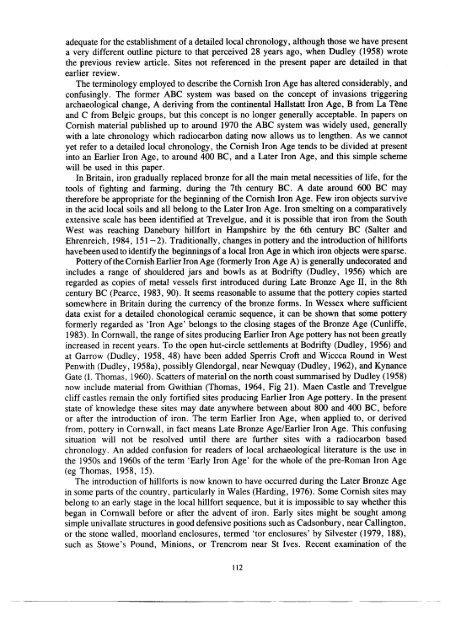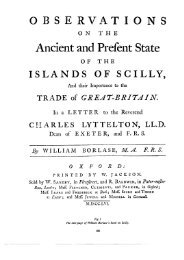Cornwall during the Iron Age and - Cornwall Archaeological Society
Cornwall during the Iron Age and - Cornwall Archaeological Society
Cornwall during the Iron Age and - Cornwall Archaeological Society
Create successful ePaper yourself
Turn your PDF publications into a flip-book with our unique Google optimized e-Paper software.
adequate for <strong>the</strong> establishment of a detailed local chronology, although those we have present<br />
a very different outline picture to that perceived 28 years ago, when Dudley (1958) wrote<br />
<strong>the</strong> previous review article. Sites not referenced in <strong>the</strong> present paper are detailed in that<br />
earlier review.<br />
The terminology employed to describe <strong>the</strong> Cornish <strong>Iron</strong> <strong>Age</strong> has altered considerably, <strong>and</strong><br />
confusingly. The former ABC system was based on <strong>the</strong> concept of invasions triggering<br />
archaeological change, A deriving from <strong>the</strong> continental Hallstatt <strong>Iron</strong> <strong>Age</strong>, B from La Tem<br />
<strong>and</strong> C from Belgic groups, but this concept is no longer generally acceptable. In papers on<br />
Cornish material published up to around 1970 <strong>the</strong> ABC system was widely used, generally<br />
with a late chronology which radiocarbon dating now allows us to leng<strong>the</strong>n. As we cannot<br />
yet refer to a detailed local chronology, <strong>the</strong> Cornish <strong>Iron</strong> <strong>Age</strong> tends to be divided at present<br />
into an Earlier <strong>Iron</strong> <strong>Age</strong>, to around 400 BC, <strong>and</strong> a Later <strong>Iron</strong> <strong>Age</strong>, <strong>and</strong> this simple scheme<br />
will be used in this paper.<br />
In Britain, iron gradually replaced bronze for all <strong>the</strong> main metal necessities of life, for <strong>the</strong><br />
tools of fighting <strong>and</strong> farming, <strong>during</strong> <strong>the</strong> 7th century BC. A date around 600 BC may<br />
<strong>the</strong>refore be appropriate for <strong>the</strong> beginning of <strong>the</strong> Cornish <strong>Iron</strong> <strong>Age</strong>. Few iron objects survive<br />
in <strong>the</strong> acid local soils <strong>and</strong> all belong to <strong>the</strong> Later <strong>Iron</strong> <strong>Age</strong>. <strong>Iron</strong> smelting on a comparatively<br />
extensive scale has been identified at Trevelgue, <strong>and</strong> it is possible that iron from <strong>the</strong> South<br />
West was reaching Danebury hillfort in Hampshire by <strong>the</strong> 6th century BC (Salter <strong>and</strong><br />
Ehrenreich, 1984, 151 —2). Traditionally, changes in pottery <strong>and</strong> <strong>the</strong> introduction of hillforts<br />
havebeen used to identify <strong>the</strong> beginnings of a local <strong>Iron</strong> <strong>Age</strong> in which iron objects were sparse.<br />
Pottery of <strong>the</strong> Cornish Earlier <strong>Iron</strong> <strong>Age</strong> (formerly <strong>Iron</strong> <strong>Age</strong> A) is generally undecorated <strong>and</strong><br />
includes a range of shouldered jars <strong>and</strong> bowls as at Bodrifty (Dudley, 1956) which are<br />
regarded as copies of metal vessels first introduced <strong>during</strong> Late Bronze <strong>Age</strong> II, in <strong>the</strong> 8th<br />
century BC (Pearce, 1983, 90). It seems reasonable to assume that <strong>the</strong> pottery copies started<br />
somewhere in Britain <strong>during</strong> <strong>the</strong> currency of <strong>the</strong> bronze forms. In Wessex where sufficient<br />
data exist for a detailed chonological ceramic sequence, it can be shown that some pottery<br />
formerly regarded as '<strong>Iron</strong> <strong>Age</strong>' belongs to <strong>the</strong> closing stages of <strong>the</strong> Bronze <strong>Age</strong> (Cunliffe,<br />
1983). In <strong>Cornwall</strong>, <strong>the</strong> range of sites producing Earlier <strong>Iron</strong> <strong>Age</strong> pottery has not been greatly<br />
increased in recent years. To <strong>the</strong> open hut-circle settlements at Bodrifty (Dudley, 1956) <strong>and</strong><br />
at Garrow (Dudley, 1958, 48) have been added Sperris Croft <strong>and</strong> Wiccca Round in West<br />
Penwith (Dudley, 1958a), possibly Glendorgal, near Newquay (Dudley, 1962), <strong>and</strong> Kynance<br />
Gate (I. Thomas, 1960). Scatters of material on <strong>the</strong> north coast summarised by Dudley (1958)<br />
now include material from Gwithian (Thomas, 1964, Fig 21). Maen Castle <strong>and</strong> Trevelgue<br />
cliff castles remain <strong>the</strong> only fortified sites producing Earlier <strong>Iron</strong> <strong>Age</strong> pottery. In <strong>the</strong> present<br />
state of knowledge <strong>the</strong>se sites may date anywhere between about 800 <strong>and</strong> 400 BC, before<br />
or after <strong>the</strong> introduction of iron. The term Earlier <strong>Iron</strong> <strong>Age</strong>, when applied to, or derived<br />
from, pottery in <strong>Cornwall</strong>, in fact means Late Bronze <strong>Age</strong>/Earlier <strong>Iron</strong> <strong>Age</strong>. This confusing<br />
situation will not be resolved until <strong>the</strong>re are fur<strong>the</strong>r sites with a radiocarbon based<br />
chronology. An added confusion for readers of local archaeological literature is <strong>the</strong> use in<br />
<strong>the</strong> 1950s <strong>and</strong> 1960s of <strong>the</strong> term 'Early <strong>Iron</strong> <strong>Age</strong>' for <strong>the</strong> whole of <strong>the</strong> pre-Roman <strong>Iron</strong> <strong>Age</strong><br />
(eg Thomas, 1958, 15).<br />
The introduction of hillforts is now known to have occurred <strong>during</strong> <strong>the</strong> Later Bronze <strong>Age</strong><br />
in some parts of <strong>the</strong> country, particularly in Wales (Harding, 1976). Some Cornish sites may<br />
belong to an early stage in <strong>the</strong> local hillfort sequence, but it is impossible to say whe<strong>the</strong>r this<br />
began in <strong>Cornwall</strong> before or after <strong>the</strong> advent of iron. Early sites might be sought among<br />
simple univallate structures in good defensive positions such as Cadsonbury, near Callington,<br />
or <strong>the</strong> stone walled, moorl<strong>and</strong> enclosures, termed 'tor enclosures' by Silvester (1979, 188),<br />
such as Stowe's Pound, Minions, or Trencrom near St Ives. Recent examination of <strong>the</strong><br />
112




